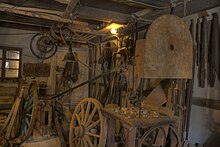Cartwright
The Stellmacherei (also Wagnerei ) is the workshop of a craftsman said Cartwright, the wheels, cars and other agricultural tools made of wood manufactures. The name of the profession varies from region to region, with wheelwright being used more in the north, while Wagner in the south and Switzerland . In addition, names can be found in the dialects that on Radmacher (Low German: Radmaker) wheels makers , axle makers or Axmacher decline. These were originally different professions; so the wheelwright made the frame, the wheel maker the wheels. Today, however, they all mostly refer to the same activity. When coach- of Wagner was responsible for the body of Radmacher however, made the wheels, their production alone comparable effort and expertise required as the bodies.
With the advent of the railroad in the late 19th century, the wheelwright's skills as wagon builders were in great demand. Their knowledge was later also required in the body shop of the car manufacturers. Since the introduction of industrial assembly line production , the importance of the wheelwright decreased.
After entire rows of houses burned down in many villages, strict regulations were issued in the 18th century under Count Palatine Karl IV to prevent a fire, which also regulated the removal of chips every evening in the Wagner workshops.
Today the wheelwright is one of the dying professions, but still leads a niche existence in certain artisanal businesses . In the GDR , the wheelwright was still a common occupation up until the fall of the Berlin Wall, especially in the rural environment . It was given all kinds of woodworking tasks, especially in agricultural production cooperatives and state- owned companies . B. the manufacture of large wooden gates, equipment or wooden structures of specially made special machines, but also carousels or traditional wooden wagons for rural festivities.
In the museum cartwright in Langenrehm , the traditional cartwright craft is preserved in the museum: The workshop is original in its condition from 1930, all machines are fully functional. On the opening days, the wheelwright demonstrates the craft and makes wooden wheels, wagons and carts in front of visitors. The exhibition in the house shows family life on the Stellmacherhof around 1930.
literature
- Hårvard Bergland: The art of forging. The great textbook of traditional technology. 4th, unchanged edition of the German edition. Wieland, Bruckmühl 2013, ISBN 978-3-9808709-4-8 , pp. 323–342: Chapter 16: The wheel maker .
- Clemens Kieser: A good bike was dear and expensive. The war wagon factory in Gaggenau-Bad Rotenfels. In: monuments in Baden-Wuerttemberg .., 37. Jg 2008, Issue 2, p 115 f, denkmalpflege-bw.de (PDF).
- Wilhelm Rausch: The wheelwright. Detailed description of the work involved in the cartwright and in the construction of trucks, commercial vehicles and hearses . Voigt, Leipzig 1899 (Reprint: Ed.Libri Rari Schäfer, Hannover 2003, ISBN 3-87870-671-5 ).
- Kurt Günter Heid: wheelwright tools, hand tools for this profession. BOD Verlag, Norderstedt 2017, ISBN 978-3-7460-2935-1 .
Web links
- Documentary The Wagner Henninger - the last of his class (1984)
- Entry on Wagnermeister in the Austria Forum (in the Heimatlexikon)
- Wagner craft in the Hohenloher Freilandmuseum Wackershofen
- Material science from the wheelwright
- Video: making a wagon wheel . Institute for Scientific Film (IWF) 1991, made available by the Technical Information Library (TIB), doi : 10.3203 / IWF / E-3106 .
- Video: Manufacture of a wagon wheel in Flaas . Institute for Scientific Film (IWF) 1983, made available by the Technical Information Library (TIB), doi : 10.3203 / IWF / E-2759 .
Individual evidence
- ↑ wheelwright. In: Jacob Grimm , Wilhelm Grimm (Hrsg.): German dictionary . tape 18 : Stehung – Stitzig - (X, 2nd section, part 2). S. Hirzel, Leipzig 1941 ( woerterbuchnetz.de ). Wheel maker . In: Jacob Grimm , Wilhelm Grimm (Hrsg.): German dictionary . tape 14 : R - skewness - (VIII). S. Hirzel, Leipzig 1893 ( woerterbuchnetz.de ). wagner. In: Jacob Grimm , Wilhelm Grimm (Hrsg.): German dictionary . tape 27 : W – way [twittering] -zwiesel - (XIII). S. Hirzel, Leipzig 1922 ( woerterbuchnetz.de ). Furthermore, the map and explanations in Werner König: dtv-Atlas German language . 15th edition. dtv, Munich 2005, p. 194-196 .
- ↑ Two trades - one job. In: Hessische / Niedersächsische Allgemeine. October 10, 2011, accessed August 8, 2018 .
- ^ Franz-Josef Sehr : The fire extinguishing system in Obertiefenbach from earlier times . In: Yearbook for the Limburg-Weilburg district 1994 . The district committee of the Limburg-Weilburg district, Limburg-Weilburg 1993, p. 151-153 .
- ↑ Dying professions. Why Theo Malchus builds wooden cars. In: Spiegel Online . January 30, 2012, accessed January 30, 2012 .


